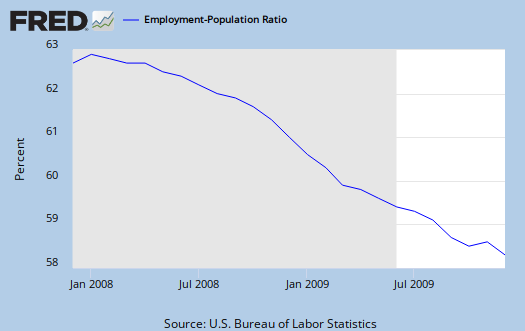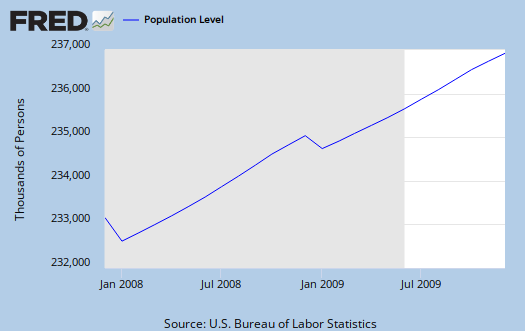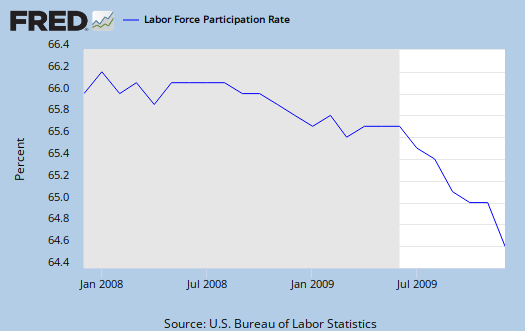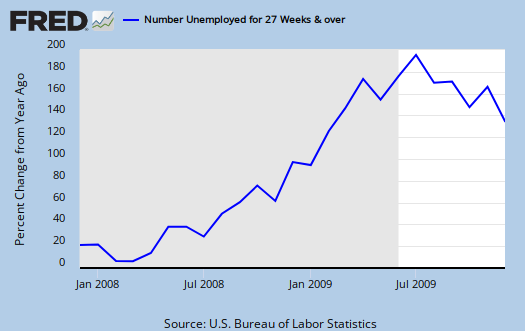Unemployment numbers for December were released today yesterday. The U.S. lost 85,000 jobs. I wanted to add to some of the details on today's figures from this earlier post and to amplify why this is so damn bad.

There are officially 15.3 million unemployed, and a year ago there were 7.7 million unemployed and an unemployment rate of 5.0%.
Civilian participation rate fell to 64.6% and the employment to population ratio dropped to 58.2%.
Here is the participation rate to population graph of this recession and bear in mind, the U.S. population has increased during this time period, so this is an astounding figure:

Here is the same graph but in bar, so you can see the continually descending slope (trend) and note the extreme decline in Q4 2008/Q1 2009:

Below is the total non-institutional civilian population, this is people age 16 and over, not locked up somewhere or in the military:

If one notices this means the U.S. working age population grew by 4 million during this recession period. This statistic does not include babies and children (we hope). Some of that population growth is due to immigration. So, let's grossly underestimate and assume only a quarter of these people are workers, somewhere the BLS is not counting a good 1 million workers and this is an obvious underestimation. Labor in the millions, is missing. How are they missing? The BLS never counts them.
Take the real civilian employment to population ratio reported, 58.2%. This means there are 2.38 million workers not be included in these tallies by the non-institutional civilian population growth rates.
Now here is the civilian participation percentage, bear in mind population has increased:

Where are the missing? Aliens did not land and pick them up. Clearly there are millions of workers not being counted because they have dropped out completely from the labor market, never entered it at all or exist in an underground economy operating on U.S. soil.
BLS reports, the long term unemployed is 6.1 million and for those counted, that's 40% have been without a job 27 weeks or longer.
Yet from the above, one can see population is increasing while those who are counted and participating are decreasing. The reality is just to keep up with a 10% unemployment rate the United States must create est. from 88,000 to 400,000 jobs per month. Looking at the above numbers for 2 years (12/07-12/09), we have 4 million non-institutional civilian population growth, assuming a 64.6% participate rate, this implies we need to generate 107,666 jobs per month just to keep the labor participation rate at 64.6% with the non-institutional civilian population growth rate. Exclude the people unemployed from this tally (participate rate includes those looking), and just tally jobs to the civilian labor force, currently at 58.2%, we require 97,000 jobs be created each month to employ the increasing civilian non-institutional population growth.
Below is the graph of the percentage change compared to one year ago on those unemployed 27 weeks or longer. One might look at this graph as a cliff, eventually one will be pushed up to fall off of it. In other words, the long term unemployment will fall off of the rolls to be counted if there is no significant job creation.

Now, let's tally some numbers:
- Part time - 9.2 million
- Discouraged workers - 929,000
- Marginally attached - 2.5 million
This is the U6, or wider unemployment rate of 17.3% reported.
Now, this is a grand total of 27.929 million unemployed or marginalized workers. Now look at non-institutional civilian population (237 million) and take it times the participation rate. That should imply we have 153.1 million employed workers.
The total number of non-farm payroll jobs in the United States is in the graph below:

Note we have currently 131 million jobs in non-farm payroll. Let me quickly remind what this statistic means.
NFP: Non-farm Payroll excludes farm workers, government workers, private serfs, slaves and bleeding hearts working for non-profits and of course...self-employed.
A very, very rough estimate of non-farm payroll to the overall working force is 80%. So take our 131 million jobs and add in the 20% of other types of civilian work. That's 164 million workers, roughly for all types of work in the civilian market.
From the civilian participation rate of the total non-institutional population we get a theoretical participation of 153.1 million, yet from the employment to population ratio we get 138 million working. Add the official unemployment tally of roughly 15.3 million people. added together that's roughly 153.2 million. Then we have 12.7 million marginally attached, forced part time which comes up to be about 165 million. This implies the above assumptions are about right, i.e. there really are at least 2 million people missing somewhere in the tallies from population growth alone. Add to this number the 810,000 who just fell off the rolls, and we have a good 3 million workers not being tallied.
What's the bottom line in this exercise? Well, if you don't like my assumptions and calculations, feel free to say why in the comments, but one cannot deny the beyond belief negative slope (trend) of the labor participation rate against the never ending increasing U.S. population rate.
I don't think all of those workers are sitting in tankers parked in the Pacific somewhere, although I am sure if it could be done, multinational labor arbitraging corporations would. (insider joke on the missing oil supply in arguing whether oil was a speculative bubble or not in 2008).
A few more notes from the BLS report: Only sectors to add jobs are temporary and health care with manufacturing losing 27,000 and construction - 53,000 and we also had November Unemployment Revisions:
The change in total nonfarm payroll employment for October was revised from -111,000 to -127,000, and the change for November was revised from -11,000 to +4,000.
| Attachment | Size |
|---|---|
| 210.97 KB |

Comments
EconomPic has yet another view on unemployment, -11.7%
Came up with an unemployment rate of 11.7% by using a 5 year rolling average of the labor force. Not a bad idea actually.
One thing is clear other bloggers are coming out with a lot of data crunching (same as above) showing there this 10% unemployment rate or "flat" rate just isn't so in reality.
And worst of all ...
...is that, if you just stick with the headline numbers and ignore all this "extra" analysis you've done, it's still a very, very grim situation.
Not pretending to be an economist&
Not pretending to be an economist
Overload
RI had 2,200 unprocessed unemployment claims at the beginning of December and they announced they would close a few days a months to take up the slack you know with no calls or walk ins so today they announced they now have 5,500 unprocessed claims and 2,200 unanswered emails from people with questions.
RI is a small state but the DLT has hired twice last year to try and catch up and then the days off thing and they are falling further behind.
I have to believe the same thing is happening across the country.